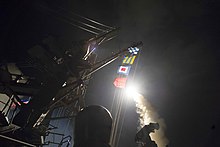A Brief History
On April 16, 2018, the World continues to watch events in Syria unfold two days after the United States, the United Kingdom, and France bombed Syrian sites deemed part of their infrastructure required to produce and store chemical weapons in response to Syrian use of chlorine and sarin poison gases against Syrian rebels, killing dozens. The Russians had tersely warned against the Western Allies taking such retaliatory action and hinted at retaliation against the West.
Digging Deeper
As the rhetoric continued back and forth between the US, its allies, and Russia, one is forced to wonder whether or not the tinder box of the Middle East may trigger a wider war resulting in massive involvement of US and its allies versus Russia and its allies, perhaps even nuclear war. As History shows, the steps to large scale war are not always easily recognized in real time when they occur (example, World War I) and we wonder whether or not the 2018 conflict in Syria may be such a case.

Since Iran and North Korea are supporters of the Assad regime in Syria, the possibility of Western strikes killing citizens of those countries or material and equipment owned or provided by those allies of Assad pose the risk of retaliation by Iran or North Korea, overtly or covertly, against the US or its allies, further increasing the risk of an expanding war. Certainly, the Russian warnings that the West better not kill Russians in Syria or destroy Russian equipment must be taken seriously. The Russians have threatened to attack the source (ships, ground units, airplanes) of Western missiles and bombs if any Russians are killed or Russian equipment is destroyed. Would shooting down American planes or sinking an American ship in turn result in massive US retaliation?

The United States promises to resume attacks against Syrian government installations should the Assad regime continue to use chemical weapons. With each such attack the chance of inadvertently (or on purpose) killing Russians, Iranians, or destroying Russian owned gear becomes more and more likely. Since Vladimir Putin operates as a de facto dictator in Russia, he does not have to worry about achieving a government consensus to act in a military fashion in Syria or elsewhere, creating an even more dangerous situation than one would normally expect. Putin has an enormous ego and operates on a cult of personality (as does President Trump), making him more mercurial than a more republican style government. President Trump operates on the assumption that he can act with military force without consulting Congress, a position disputed by some legislators (mostly Democrats), so his sensitive ego may also be a factor in any scenario concerning military escalation.

Adding to the potential disaster in the making is Israel, a pugnacious neighbor of Syria that does not hesitate to launch retaliatory attacks into Syrian territory any time terrorists launch missiles into Israel, further threatening to draw in other Muslim countries into a possible Arab-Israeli conflict, a conflict likely to draw in American and Russian involvement.
Question for students (and subscribers): So far the aftermath of the US and Allied attacks against Syrian chemical weapons infrastructure has been relegated to rhetoric and threats on both sides, but will this remain the situation? Have we already started on the slippery slope to war? Please share your opinions and analysis of the situation, and feel free to say whether or not you believe the US should be bombing Syria for gassing their own people, in the comments section below this article.
If you liked this article and would like to receive notification of new articles, please feel welcome to subscribe to History and Headlines by liking us on Facebook and becoming one of our patrons!
Your readership is much appreciated!
Historical Evidence
For more information, please see…
Melemed and Aharish. Inside the Middle East: Making Sense of the Most Dangerous and Complicated Region on Earth. Skyhorse Publishing, 2016.
Mitchell, Chris. ISIS, Iran and Israel: What You Need to Know about the Current Mideast Crisis and the Coming Mideast War. C & L Publishing LLC, 2016.
Pearlman, Wendy. We Crossed a Bridge and It Trembled: Voices from Syria. Custom House, 2017.
The featured image in this article, a photograph by Fathi Nizam of buildings destroyed by allied missile strikes, 14 April 2018, is licensed under the Creative Commons Attribution 4.0 International license. This image is from the Tasnim News Agency website, which states in its footer, “All Content by Tasnim News Agency is licensed under a Creative Commons Attribution 4.0 International License.”


